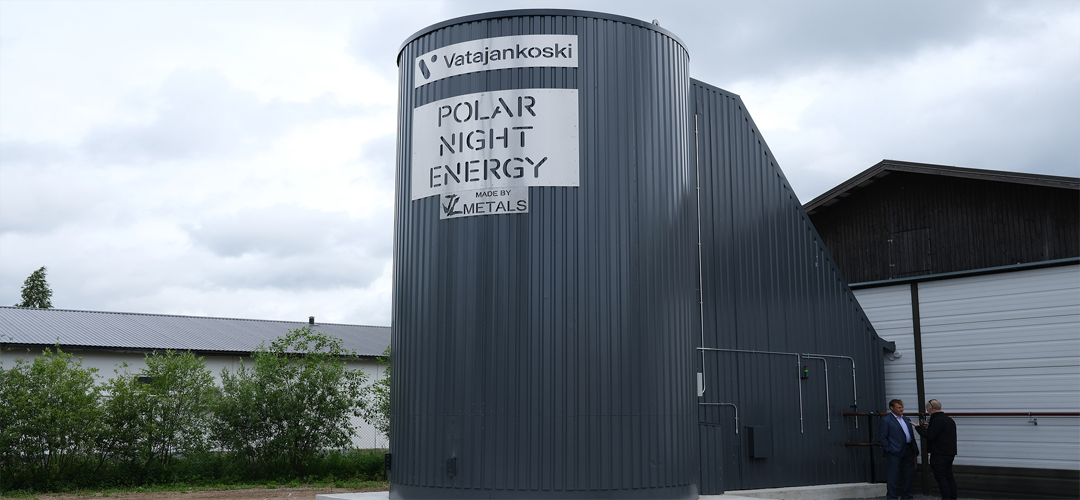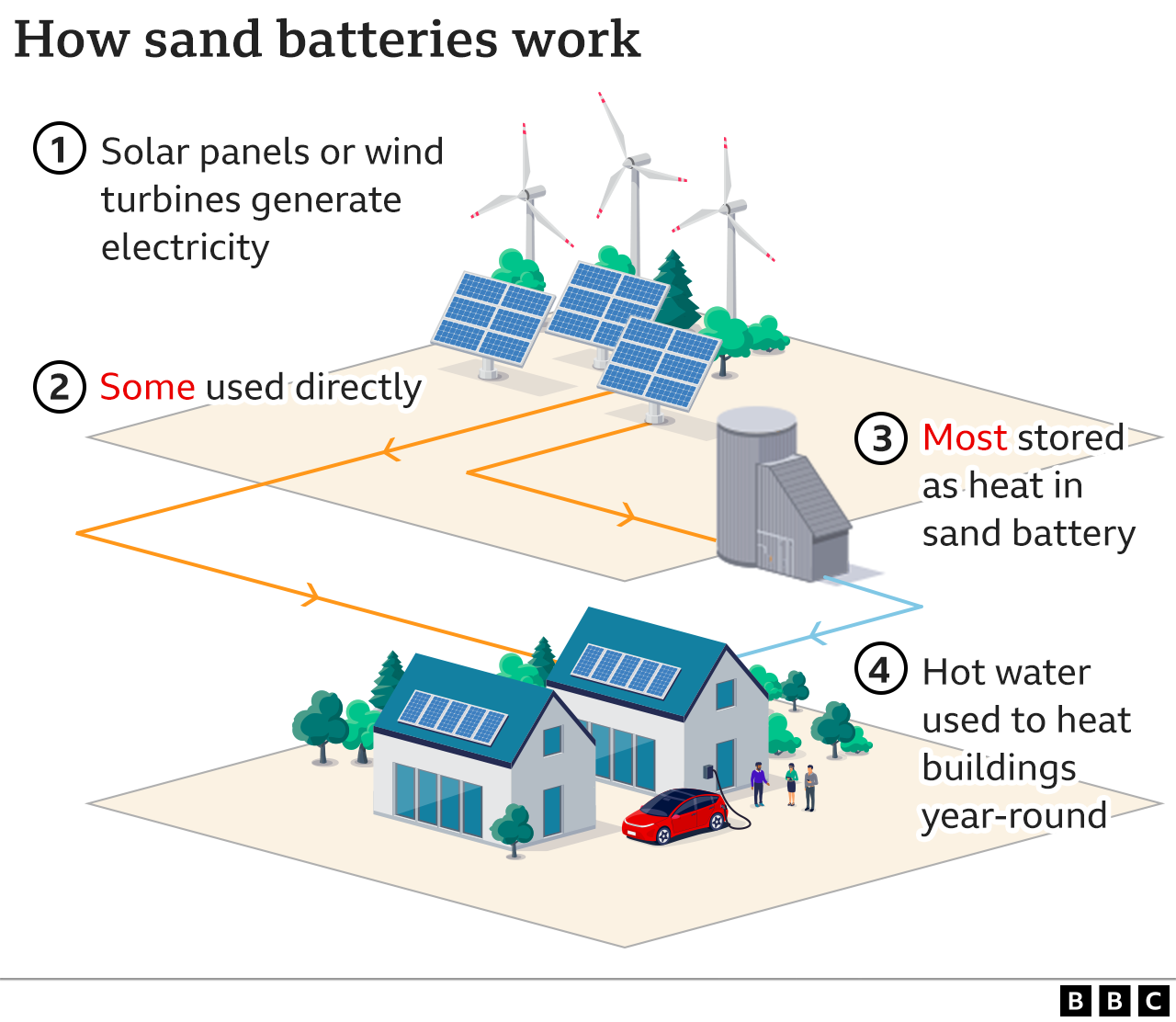SAND BATTERIES: THE NEXT GREEN ENERGY REVOLUTION?
November 19, 2022 | Expert Insights

The intermittent nature of supply is halting the march towards renewable energy sources that most can generate. Solar and wind energy-driven generators are dependent upon the whims of nature. They need affordable, dependable and long-lasting energy storage devices to ensure an uninterrupted supply to consumers. The existing storage batteries, lead acid type and lithium-ion based, have their own challenges, making renewables an expensive and unreliable energy source.
Perhaps all this could change if the development of ‘sand batteries’ can achieve a commercial, technological breakthrough. They hold out the promise of upscaling the production and storage of renewable energy by making it more profitable and sustaining while keeping it clean and green.
Background
A sand battery is a high-temperature thermal energy storage that uses sand or materials that resemble sand as its storage medium. It is a well-known fact that sand can store energy in the form of heat. Sand batteries could replace conventional batteries to store energy produced more than online consumption by wind and solar generators. The energy is converted to heat, which can heat buildings or supply hot steam and high-temperature process heat to sectors of the economy that are frequently dependent on fossil fuels.
The first operational "sand battery" has been constructed by the Finnish businesses Polar Night Energy and Vatajankoski, offering a low-cost and low-emission method of storing renewable energy. Polar Night Energy claims that it helps to overcome one of the major challenges in the move to fully renewable energy: how to store it for use when the sun isn't shining or the wind isn't blowing, especially for usage in the winter when demand is high.
The first industrial-scale sand battery in the world is located in the Vatajankoski power station. The battery comprises 100 tonnes of low-grade builders' sand, two heating pipes, and a fan and is completely encased in a 7m (23ft) high steel container. Sand is heated to 6000 C, utilising electricity produced by Finnish wind turbines and solar farms, which is released from the sand battery for heating other applications.
The resistive heater that heats the air inside the sand is powered by renewable energy. A fan moves this heated air around the sand inside the battery through heat exchange pipes. When fully charged, the battery can hold 8 MWh of thermal energy. When energy demand increases, the battery releases roughly 200 kW of electricity through the heat-exchange pipes, sufficient to augment grid power and provide heating and hot water for about 100 residences and a community pool. The battery can be charged overnight when electricity charges are lowest.

Analysis
Researchers claim that sand batteries are inexpensive to construct and easy to maintain. Since inexpensive, low-quality sand is used and not high-quality river sand that is globally so much in demand, the cost is kept low. The heat exchange pipes and the sand don't experience wear and strain. The only moving component is the fan, which is simple to replace if necessary.
Sand is a particularly efficient heat-storage material that can hold heat for months at a time. There are also additional advantages. The sand may heat up and cool down numerous times. After some time, it will become denser, require less space, and more sand can be added.
Today Lithium is the primary material utilised in industrial-scale batteries that are used to store electricity produced intermittently by renewable energy sources. They struggle to handle significant amounts of extra electricity and are huge, pricey, and prone to explosions.
On the other hand, the sand battery is a cheap alternative that can endure large power surges and doesn't call for new, uncommon elements. Sand batteries can maximise system efficiency by instantly storing high waves of energy from renewable sources. As a result, when energy prices are higher, the battery can discharge hot air to heat homes, offices, and the neighbourhood pool at a much lower cost.
The introduction of the sand battery comes at a time when utility companies and power networks worldwide are making significant investments in renewable energy. An increasing number of solar farms, wind turbines, and geothermal energy systems are being built worldwide due to recent advancements in renewable energy technology and pricing.
But adding more capacity for renewable energy generation to the country's grid is only a portion of the issue. Storage is equally crucial, particularly in areas more susceptible to seasonal weather variations, like northern Europe.
Since electricity grids must keep the network in balance, adding a wave of power from renewable sources—for instance, during a storm when wind turbines operate at maximum capacity—could cause the network to become unbalanced. By absorbing power surges and later releasing that energy when the grid needs it, efficient battery storage can assist engineers (and, increasingly, automated systems) in maintaining grid balance.
In addition to the Finnish partnership, research organisations worldwide are also looking into the sand. For instance, the U.S. National Renewable Energy Laboratory (NREL) is now researching sand batteries.
With the installation of the first functional commercial sand battery, it might soon be that this affordable, effective technology permeates the world's power systems.
.
Assessment
- For Nordic nations, where there are long stretches of darkness and a greater need for heat in the winter but longer stretches of sunlight in the summer, effective storage of solar and wind energy is extremely important.
- Finland is encouraging the EU to enhance its renewable energy supply in the aftermath of the conflict in Ukraine. According to the prime minister, the only way out of the energy problem is to invest significantly in creating renewable and emission-free energy. This is where storage devices like sand batteries will play a crucial part.








Comments